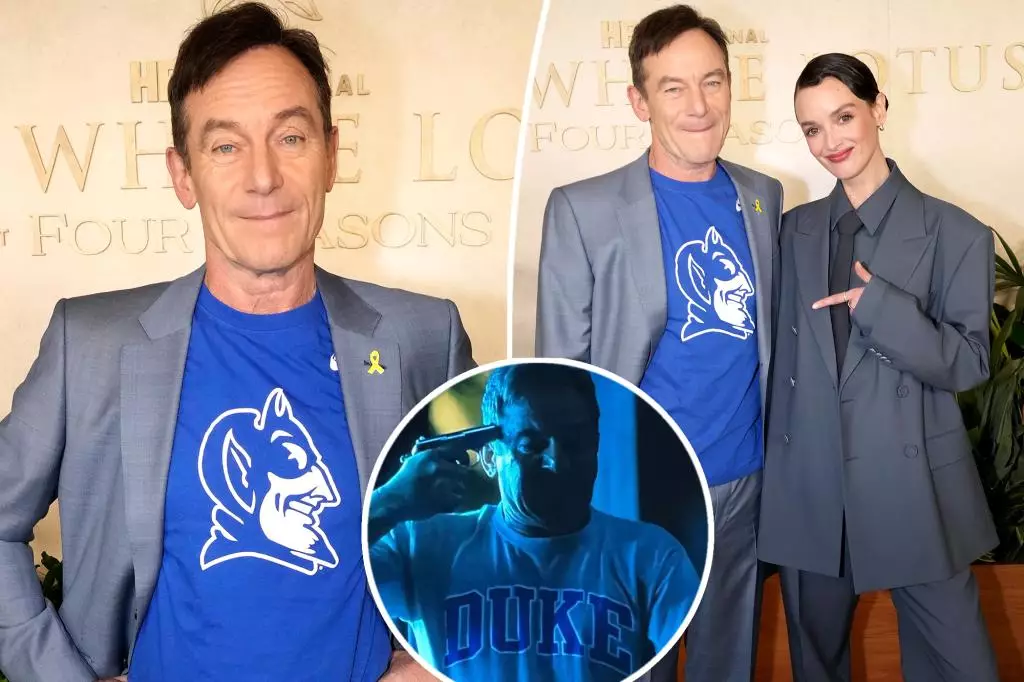Jason Isaacs has taken the role of Timothy Ratliff in HBO’s “The White Lotus” to new heights, blending humor and tragedy in a character that has become synonymous with blue pride—an undeniable testament to the power of visual storytelling. At the recent finale event at the luxurious Four Seasons Hotel in Westlake Village, California, Isaacs made headlines not only for his performance but for his bold fashion choice: a gray suit complemented by a conspicuous Duke University T-shirt. This subtle act was as much a commentary on his character as it was a ripple through social media, showcasing how clothing can carry deeper meaning and provoke dialogue about institutional representation and artistic liberties.
The Controversy Surrounding Brand Representation
However, this clothing choice did not come without repercussions. Duke University expressed concern over its logo being utilized without permission, branding the depiction as “troubling.” This dispute underscores the ongoing tension between artistic expression and brand autonomy. Frank Tramble, Duke’s vice president for communications, articulated the university’s position, stating that while they value creativity, the way their brand was presented could mistakenly suggest an endorsement, highlighting the fine line between homage and appropriation. This situation begs the question: to what extent should creators be allowed to manipulate real-world brands for the sake of narrative impact?
A Season of Contrasts: Humor and Dark Themes
“The White Lotus” has masterfully intertwined humor with dark, thought-provoking themes, making it a rich subject for analysis. Ratliff’s recurring blue T-shirt serves as a metaphorical backdrop against which the character navigates a self-destructive arc—a father entangled in a conspiracy while contemplating his own mortality. This juxtaposition of a casual garment against intense narrative stakes creates an unsettling tension, prompting viewers to reconcile the light-hearted with the deeply disturbing. The series effectively capitalizes on such contrasts, inviting audiences to reflect on the absurdity of life’s dualities.
Cultural Reflections through Fashion Choices
The fashion displayed at the finale event encapsulates how style not only defines character but also serves as a cultural commentary. Co-stars like Patrick Schwarzenegger and Charlotte Le Bon showcased bold silhouettes—Schwarzenegger in a striking white pinstripe suit and Le Bon in a power suit—reinforcing their characters’ journeys while capturing the essence of a series that challenges societal norms. Each actor’s ensemble contributes not only to their on-screen personas but also to a larger discussion on empowerment through fashion, illustrating how clothing can evoke authority and confidence.
Embracing the Spirit of the Show
Ultimately, what Jason Isaacs and his co-stars brought to the red carpet transcended mere aesthetics; it was a celebration of the show’s spirit. As “The White Lotus” delves deep into complex narratives that challenge viewers’ perceptions, the apparel worn by its cast reaffirms the boldness of their characters. This interplay of personal style and narrative purpose encourages audiences to consider their own relationships with social symbolism and branding, proving that clothing in media is far more than fabric; it’s a dialogic force that speaks to our values and identities. As the series concludes, one can’t help but feel captivated by how provocative storytelling—and, yes, even T-shirt choices—affect our understanding of culture and art.

